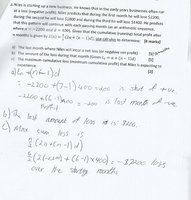writer2019
New member
- Joined
- Apr 1, 2019
- Messages
- 19
Emma is starting a new business. he knows that most business when they start run at loss. Emma predict that in the first month she will lose $2200, in the second he will loose $1800 and in the third she will lose $1400 and this pattern will continue with each passing month (like arithmetic sequence where a=-2200 and d=400). Given the cumulative (running) total profit after n months is given by S(n)=n/2 (2a+(n-1)d) use calculus to determine:
a) The last month Emma will incur a net loss
b) The amount of loss during that month (given tn=a+(n-1)d)
c) The maximum cumulative loss (minimum cumulative profit) that Emma will experience
My working for this is quite stupid in my opinion. I try to work out these question by using the arithmetic sequence formula when we are asked to use calculus. I am not sure where to start to use calculus to solve this
Here is my working out:
a) t1+(n-1)d
-2200 + (7-1)*400 = 200
Thus during the seventh month it will be the start of the positive.
-2200 + (6-1)*400 = -200
In the sixth month it will be the last month of a loss.
b) the loss on the last month will be $-200.
The maximum cumulative loss by Emma will be
n/2 (2a+(n-1)d)
6/2 (2(-2200)+(6-1)*400 = $-7200 loss
Is my working out for the answer correct and if they are how can I use calculus to solve the questions?
a) The last month Emma will incur a net loss
b) The amount of loss during that month (given tn=a+(n-1)d)
c) The maximum cumulative loss (minimum cumulative profit) that Emma will experience
My working for this is quite stupid in my opinion. I try to work out these question by using the arithmetic sequence formula when we are asked to use calculus. I am not sure where to start to use calculus to solve this
Here is my working out:
a) t1+(n-1)d
-2200 + (7-1)*400 = 200
Thus during the seventh month it will be the start of the positive.
-2200 + (6-1)*400 = -200
In the sixth month it will be the last month of a loss.
b) the loss on the last month will be $-200.
The maximum cumulative loss by Emma will be
n/2 (2a+(n-1)d)
6/2 (2(-2200)+(6-1)*400 = $-7200 loss
Is my working out for the answer correct and if they are how can I use calculus to solve the questions?

